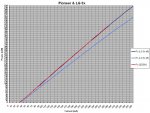its beginning, great!

interesting, the forward voltage flattens out.. perhaps we could see some kind of limit by observing the voltage, how far to go maximum? just guessing here!
manuel
It never really flattens out, but it is true, that smaller and smaller increases in voltage are needed to achieve the same increase in current...
Sometimes (towards the end) the difference between 10mA is as little as ~0.01V (that's the resolution of my Diode Analyzer)..
But it would be physically impossible for it to become flat-flat, if you know what i mean.
I don't know if this means anything or not.. And it also has a lot to do with heat.. I don't have constant temperature for the plotting yet. And Vf drops as the temperature goes up... The testing setup was actually my v3 heatsink/module in a laser body - no extra heatsinking (and yet the Po line remained straight)!
The power should have curved down a bit as well, but it's not really noticable in the graph.. However if i were to set this laser to 360mA and run it cold, it would have ~465mW instead of the 458mW where it peaked in the plot... So i guess this curving due to heat is so gentle and slow that we don't really see it..
There was a moment where my Diode Analyzer suddenly shut down! One of the Li-Ions powering it went into underdischarge protection! I had to replace it. During this time the laser cooled off, and when i turned the Analyzer back ON again, surprisingly the power line continued straight, but the temperature difference produced a slightly noticable "jump" in the Vf line... :angel:
Another thing i wanted to say... The "slightly" lower efficiency of the first LG 8x i tested, compared to the first Pioneer 8x i tested worried me a little at first.
So i made another plot. This time comparing 8x diodes to 6x diodes, or rather A 6x diode and a 100mW CW Nichia (which seeems to be the same thing +/- a few mW in rating - identical to high efficiency GGWs)...
This plot now shows four diodes:
- the two blue
(ish) ones are 8x's
- the two red
(ish) ones are 6x's...
The red one is my first personal 6x out of a GGW drive, which cost me about $300 to obtain! After going through almost 70 reject GGW sleds, i now classify a GGW with such an efficiency as a "normal" GGW diode...
The 100mW Nichia just had a higher efficiency, but there are GGWs, that match it or even exceed it... I call those "high efficiency" or "freaks"...
The reason i'm showing this plot is this..
I believe that the LG 8x is a "normal" efficiency 8x diode...
The Pioneer 8x i used to make FrancoRob's laser just happened to be a higher efficiency one!
But the angle between the two 8x's is no different than the angle between a normal and a high efficiency 6x...
And that is good! Because i know that my "normal" efficiency 6x diode lasted a year of extreme abuse!
It was often ON for 30 or even 60 minutes at once, just to record a power stability graph, it was once even forgotten ON till the battery went flat (3 hours)!
I never used any kind of duty cycle with it, and towards the end i even had to raise the current for it to finally die!
My point is, that this LG 8x i tested last night is not a low efficiency diode. It's most likelly a normal or average efficiency one. As i already explained in an earlier post, i don't believe the manufacturers use low efficiency diodes for drives - it simply wouldn't work (every low efficiency GGW i test dies rapidly!)...
It's possible we will find slightly lower efficiency ones among the next 12 i'll test, some small variations are to be expected, some might stand out a little more than others, but i don't expect any REALLY BAD diodes.
If i had to guess, i'd say the rest of the plots will likelly be within the two blue lines already on this graph. But there could be exceptions. And if such an exception goes below the lower blue line, it will be our designated murder-candidate... :evil:
It's just natural selection folks... :angel:
P.S. And before someone asks, the 8x's were tested with the 405-G-1 lens, the 6x and Nichia were tested with an AixiZ acrylic (it was a long time ago)...
But this doesn't matter in this case, because all i was interested in was the DIFFERENCE between the SLOPE ANGLES!
If the 6x and the Nichia were given a short FL AR coated lens, their two lines would probably almost overlap the two blue lines.... I just did this plot to compare a normal diode to a high efficiency diode for both 6x's and 8x's...
Now i feel much more confident that we won't find weakling diodes in drives...





